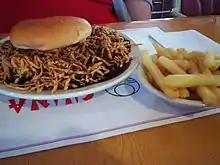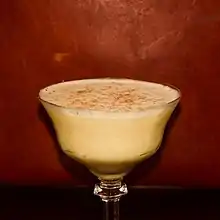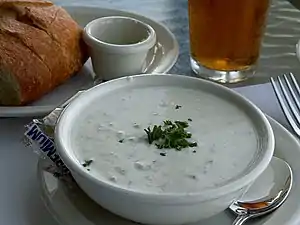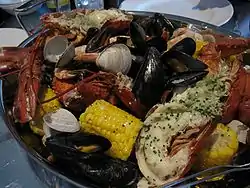Cuisine of New England
New England cuisine is an American cuisine which originated in the New England region of the United States, and traces its roots to English cuisine. It is characterized by extensive use of seafood and dairy products, which results from its historical reliance on its seaports and fishing industry, as well as extensive dairy farming in inland regions. Many of New England's earliest Puritan settlers were from eastern England, where baking foods (for instance pies, beans, and turkey) was more common than frying, as was the tradition elsewhere.[1]
| Part of a series on |
| American cuisine |
|---|
|

Two prominent characteristic foodstuffs native to New England are maple syrup and cranberries. The traditional standard starch is potato, though rice has a somewhat increased popularity in modern cooking. New England cuisine predominantly uses ground black pepper, although parsley, garlic, and sage are common, with a few Caribbean additions such as nutmeg, plus several Italian spices. Use of cream is common, due to the reliance on dairy. The favored cooking techniques are stewing, steaming, and baking. Many local ingredients, such as squash, corn and local beans, sunflowers, wild turkey, maple syrup, cranberries and dishes such as cornbread, Johnnycakes and Indian pudding were adopted from Southern New England Algonquian cuisine.
History

Early history
The traditional diet of the Wampanoag people included chestnuts, beechnuts, walnuts, beans, multi-colored corn (called "flint corn"), and varieties of squash and pumpkins.[2] Not strictly vegetarian, the traditional diet of the Wabanaki people is plant-centric and based on corn, beans, squash, sunflower seeds, sunchokes and ground cherries.[3] The Wabanaki tribal nations did make plant milk and infant formula from nuts.[4]
American colonies
In 1620, the newly arrived Pilgrims faced the prospect of surviving their first winter in Plymouth Colony. The climate was harsh and the growing season was shorter than they were accustomed to due to the long and frosty winters. The newly arrived colonists brought vital techniques of food preservation like smoking, curing and drying that helped them survive the harsh New England winter.[5] They also received help from the Wampanoag, who taught the newly arrived Pilgrims how to grow the staple crops of squash, beans and corn.[5] It is not known for certain what crops were grown in early colonial gardens, but later sources mention turnips, onions, carrots, garlic and pumpkins.[2]
The Pilgrims used corn to make hasty pudding and Wampanoag recipes like popcorn, sagamite and nasaump. The Wampanoag also taught the Pilgrims to bake in hot ashes, and ash cakes (also called johnny cakes or breakfast bannocks) became a staple breakfast bread. Beans were used to make stews or combined with corn to make succotash.[6][7]
Many of New England's earliest Puritan settlers were from eastern England and brought with the traditions of English cuisine with them. Roast duck, goose, lamb, and hams were brought to the so-called "New World" as farmyard stock as soon as the colonies began to prosper. Even today, traditional English cuisine remains a strong part of New England's identity. Some of its plates are now enjoyed by the entire United States, including clam chowder, baked beans, apple pies, baked or roast turkey, pease porridge, and steamed puddings.[1][8]
Thanksgiving
The first Thanksgiving meal was shared by the Wampanoag and Pilgrims at Plymouth Rock. The menu would have been considerably more humble than the modern Thanksgiving dinner which typically includes turkey with stuffing, cranberry sauce, candied yams, mashed potatoes and pumpkin pie. Though filled pastries were common in English cuisine, the colonists did not have wheat flour or butter, so pie would have been absent from the original Thanksgiving table. White potatoes and sweet potatoes had not yet reached North America, and the first literary mention of cranberry sauce dates some 50 years after the first Thanksgiving meal.[2]
The original menu included "Indian corn", wild fowl, including wild turkey and waterfowl, and venison. These are only foods mentioned by primary sources, however food historians have speculated as to what else may have been served. In addition to wild turkey, duck and goose, swan and passenger pigeons were plentiful. In those times birds were typically stuffed with onion and herbs and one 17th century recipe for goose includes a stuffing of chestnuts. It is likely that the meal included local seafood like clams, mussels, lobsters and eels.[2]
19th century

Since the 1800s New England's culinary traditions have been influenced by the arrival of Irish Americans, Portuguese Americans, and Italian Americans.[9] Irish-style braised pickled beef was the origin of New England boiled dinner.[5]
"Country stores" sold homemade jams, fruit preserves and penny candy. Common crackers are still made with the original recipe dating to 1828.[5]
Vegetarianism was practiced during the 18th and 19th century by individuals and families in Maine before the start of the modern vegetarian movement in 1817 in Philadelphia.[10][11]
Modern
In the post World War II era July 4 celebrations frequently feature steak, hot dogs, hamburgers and grilled chicken. In the more distant past lamb was more traditional inland, and coastal communities in New England typically served salmon with dill mayo, peas, new potatoes and corn on the cob. Dessert often includes a seasonal fruit, for example strawberry shortcake and blueberry pie.[5]
Traditional foods and drinks
Beer and alcohol
Drinks in the Colonial era were made with local ingredients like honey, molasses, apples, hops and wild berries. These drinks included apple brandy ("applejack"), fruit wines, rum and mead. Some of the finest rum distilleries were located in New England prior to Prohibition.[12]
The hot ale flip is a traditional drink historically made by mixing a pitcher of beer with rum, frothy eggs and a sweetener like dried pumpkin, maple syrup or molasses. The beverage was warmed by plunging a hot poker into the drink to caramelize the sugars creating the drink's characteristic hot froth.[13] Like the flip, the Rattle-Skull was a mix of beer (in this case a dark beer like porter) and hard liquor - usually a mix of rum and brandy. The beverage is flavored with lime and garnished with nutmeg.[14]
The Stone Fence was a mix of hard cider and rum. Reportedly, Ethan Allen and his men drank it before their raid of Fort Ticonderoga in 1775.[14] Egg cider was made by cracking eggs into heated cider and adding a sweetener like molasses. Another cider based beverage syllabub was made with rum, cream and sweetener. Mulled cider could be made with sweetener, spices, rum and egg yolks.[15]
Birch beer, made with sap from the betula lenta tree, was made by both the English and early American colonists. The betula lenta is known for producing a fragrant sap with a unique minty flavor. John Mortimer wrote that birch beer was usually made by the poor by boiling birch sap with sugar and fermenting it with yeast.[16]
Many local breweries produce lagers and ales. Notable examples include Samuel Adams of the Boston Beer Company in Boston (even though the recipe for the beer does not come from New England); Sea Dog Brewing Company of Bangor; Shipyard Brewing Company of Portland; Smuttynose Brewing Company of Portsmouth, New Hampshire. Vermont-based Woodchuck Draft Cider is a popular alcoholic cider. New England has also played a major role in the craft beer revolution, with Connecticut, Massachusetts, and Vermont having notable breweries such as Treehouse Brewing Company, Trillium Brewing Company, The Alchemist Brewery, Rock Art Brewery, Long Trail Brewing Company, Kent Falls Brewing Company and Two Roads Brewing Company.
Casseroles, soups and stews
The custom of bringing one-dish casseroles (also called hot dishes) to barn raisings and church suppers was not exclusive to New England, but included traditional variations of baked beans and succotash. Modern recipes can be made with any ingredients available at markets.[17] Seafood casseroles are made with cream sauce and bread crumb topping.[18]
American chop suey is a casserole dish made with ground beef, macaroni and a seasoned tomato sauce.[19] Though unrelated to Hungarian goulash, in other regions of the United States it may be called American goulash amongst other names.[20]
Fruits

Blueberries are made into jams and jellies and feature in breads and regional desserts like pies, cobblers and cakes.[5]
Wild beach plums are foraged and used to make fruit preserves like jams and jellies. Beach plums were cultivated and used for the commercial manufacture of beach plum jelly in the 1930s, but beach plum products are no longer widely available in commercial markets.[21]
The local purple concord grapes are a cross between native and European grapes. The large grapes are prized for their juiciness and used in the production of commercial grape juice, wine and grape jelly. It is a common ingredient in peanut butter and jelly sandwiches.[5]
Until the pilgrims planted apple seeds from Europe, the only regional apples were crab apples. Cross-pollination altered the results of these first attempts, but over the years thousands of new varieties were bred by the pilgrims. William Blaxton planted the first apple orchard in 1625. The earliest apple varieties produced in New England included Lady (1628), Roxbury Russet (1630), Pomme Grise (1650), Baldwin (1740), Porter (1800), Mother (1844) and Wright (1875).[5] In modern times apples are grown commercially throughout Massachusetts.[22]

The first attempts at commercial cranberry growing were pioneered by Captain Henry Hall, who developed the technique of covering the vines with sand to accelerate the plant's growth.[5]
Hot dogs
New England hot dog rolls are split on top instead of on the side, and have a more rectangular shape. While smaller than common hot dog rolls, New England hot dog rolls have a larger soft surface area which allows for buttering and toasting, which are also commonly used for convenient serving of seafood like lobster or fried clams. Regional bread makers often differentiate between these and the more traditional-style American hot dog rolls by referring to the New England variation as "Frankfurt Rolls" on packaging, with both commonly available next to each other on store shelves (though when purchasing a cooked hot dog or seafood "roll" from a restaurant or food stand, the Frankfurt style is almost exclusively used).[23]
Maple syrup

Maple sap is collected annually during New England's "sugaring season". The new sap is reduced and thickened to form syrup. An issue of Yankee dating from 1939 gives some details on seasonal recipes with recipes for maple butternut fudge, maple sauce ice cream and "Sugar on Snow".[24] Sugar on Snow, a regional specialty also called maple syrup taffy, is made by pouring freshly heated maple syrup on fresh snow, forming candy with a taffy consistency as the syrup hardens.[25]
Desserts like cobbler and maple custard pie were made with local sweeteners like maple sugar instead of sugar.[5] Molasses and rum were common in New England cuisine, due to New England's involvement in the Triangle Trade in the 18th century.[26] Molasses from the Caribbean and honey were staple sweeteners for all but the upper class well into the 19th century.[12]
Sandwiches

Sandwiches typical of New England's cuisine include baked bean on Boston brown bread; the Fluffernutter with Fluff marshmallow creme and peanut butter, usually served on Wonder bread; served cold or hot, lobster rolls can optionally include fixings like mayo or warmed butter; clam rolls dressed with tartar or cocktail sauce on a New England style hot dog bun; and chow mein sandwich with noodles, celery, onions, meat and sauce in a hamburger bun; from Fall River, Massachusetts.[27]
Seafood
The waters of the Gulf of Maine and Long Island Sound provide a rich variety of fish and shellfish that are a signature of the cuisine in New England. Commercial cod fishing along Cape Ann dates back as far as 1623 when salt cod was carried by merchant vessels to Africa, which returned with slaves for plantations in the Caribbean before carrying sugar back to New England. Cod, the fish for which Cape Cod is named, remains a staple of the regional cuisine to this day.[5] Bluefish can be found throughout Cape Cod and Nantucket during the summer months and is consumed smoked, broiled or sauteed.[5] American lobster is usually consumed grilled, steamed, or boiled.
Breaded deep fried clams are popular pub fare in New England. The regional clam varieties can be soft shell or hard shell and include razor clams; the latter of these is more likely to be caught by hand owing to how difficult it is to harvest them without damaging the beach upon which they dwell. Hard shell clams are sometimes called littlenecks, cherrystones or quahogs depending on their size. These are used to make New England style clam chowder, and may also be consumed steamed or even raw. The preferred methods of preparing soft-shell clams (also called "steamers") are frying or steaming. Adapted from the Native Americans, the clambake is a traditional meal in New England where clams, lobsters and corn are cooked over a firepit. Modern versions of the dish may include mussels, fish, crabs and non seafood ingredients like chicken, sausage, potatoes and other root vegetables.[5]
The official state fish are as follows:[28]
| State | Fish | Shellfish |
|---|---|---|
| Maine | Land-locked salmon (freshwater) | |
| Massachusetts | Cod | |
| New Hampshire | Striped bass (saltwater) Brook trout (freshwater) |
|
| Vermont | Brook trout Walleye pike |
|
| Rhode Island | Quahog | |
| Connecticut | Eastern oyster | |
Seasonings
Many herbs were uncommon, particularly Mediterranean herbs, which are not hardy in much of New England away from the coast. As a result, most savory New England dishes do not have much strong seasoning, aside from salt and ground black pepper, nor are there many particularly spicy staple items.[12] Other dishes meant as desserts often contain ingredients such as nutmeg, cinnamon, allspice, cloves, and ground ginger which are a legacy of trade with the Caribbean Sea that began in the 17th Century and lasted well into the 19th.
Pizza
Much of the pizza in New England is Greek pizza, owing to the strong presence of Greek immigrants and Greek Americans in the food service industry in New England. Greek pizza (as understood in New England) is typified by its chewy, bready crust similar to focaccia, which is baked in shallow, round metal pan liberally coated with olive oil. Greek-style pizzerias in New England are often found under the name "House of Pizza".
Italians emigrated to New England beginning a little over a century ago, and Southern New England pizza tends to be more Italian influenced. World famous restaurants such as "Pepe's Pizza" in New Haven, CT serve a thin, wood fired, hand tossed style of pie. "New Haven" style pizza is typified by a slightly burnt, crunchy exterior crust and soft, slightly chewy interior. Southern New England pizza (or apizza) is closely related to Neapolitan style pizza. [29]
List of foods common to New England cuisine
-
- Fried oysters
- Oyster stew
- Raw oysters on a halfshell
- Cranberry cocktail
- Cranberry mash/crushed cranberries
- Jellied cranberries
- Cranberry sauce
- Cranberry relish
- Cranberry bread
- Frappes or cabinets[36]
- Hermits
- Ice cream
- New England boiled dinner
- New England Pot Roast (Yankee pot roast)[37][38]
- Parker house rolls
- Pâté chinois
- Pumpkin pie
- Red flannel hash[39]
- Rhubarb pie
- Snickerdoodles
- Steak bomb
- Steak tips
- Tourtière
Regional specialties
Connecticut

Irish American influences are common in the interior portions of the state,[40] including the Hartford area. During the 18th century the Hartford election cake was a spicy, boozy yeast-leavened cake based on a traditional English holiday cake.[41] During the colonial era elections were celebrated with drink and a huge celebration cake large enough to feed the entire community, and the recipe as given by Amelia Simmons in 1796 called for butter, sugar, raisins, eggs, wine and spices in enormous quantities.[42] Hasty pudding is sometimes found in rural communities, particularly around Thanksgiving.[43]
Italian-inspired cuisine is dominant in the New Haven area,[44] which is known for charred thin-crust New Haven-style pizza baked in coal-fired ovens. The well-known white clam pie is made with fresh clams, olive oil, fresh garlic, oregano and grated Romano cheese.[45] Some pizza places also offer subs on Italian bread ("grinders") and standard Italian fare like eggplant rollatini, manicotti, baked ziti and chicken parmesan.[46] Well-known pizzerias include Pepe's Pizza, Sally's Apizza and Modern Apizza.[47]
The cuisine of Southeastern Connecticut is heavily based on the local fishing industry. Typical New England seafood dishes are available at local restaurants like Abbot's Lobster in the rough. Lobster rolls, crab cakes, oysters, clam chowder, steamer clams and mussels are served with sides like potato chips, remoulade sauce and coleslaw. Shad is the state fish and is cooked on planks (usually hickory, oak, or cedar) by the fire, called a "shad bake", deboning the fish requires some skill with a boning knife.[48]
Louis' Lunch began as a lunch wagon started by Danish immigrant Louis Lassen in 1895. Their burgers are still cooked in the original antique cast iron broiler.[49] A local specialty of Meriden, Connecticut, steamed cheeseburgers started as simple steamed cheese on a roll sandwiches sold off horse-drawn food carts in the 1900s. Some believe the hamburger originated in New Haven at Louis', and like the butter burger and deep-fried hamburger, the steamed version may be remnant of an earlier time before the broiled hamburger on a bun became the standard form.[50]
Ice cream is made with milk from local creameries at UCONN Dairy Bar using a century old recipe to produce 24 different flavors of ice cream. Ferris Acres Creamery is a 150 year old dairy farm offering 50 flavors of ice cream. The most popular is the "Cow Trax" - a base of vanilla with peanut butter swirls and chocolate chips.[51]
Maine

Maine is known for its access to fresh, local foods and many farms. Northern Maine produces potato crops, second only to Idaho in the United States.[52] Fiddlehead ferns were part of the Native American cuisine and are still prized in Maine, where they are gathered in springtime.[53][54] Wild blueberries are a common ingredient or garnish, and blueberry pie is the official state dessert (when made with wild Maine blueberries).
Maine is known for its lobster. Relatively inexpensive lobster rolls—lobster meat mixed with mayonnaise and other ingredients, served in a grilled hot dog roll are often available in the summer, particularly on the coast.
The whoopie pie, which is also a staple in the Philadelphia/Pennsylvania Dutch cuisine, is the official state treat.[55] Maine is the place of origin for the needham, a dessert bar made from chocolate, coconut, and potato.[56] Wax-wrapped salt water taffy is a popular item sold in tourist areas, although it is originally from New Jersey.[55]
The city of Portland, Maine, is known for its numerous nationally renowned restaurants; it was ranked as Bon Appétit magazine's "America's Foodiest Small Town" in 2009.[57] The city has the Portland Farmers Market, founded in 1768, and the city ranks as a top city for vegans and vegetarians.[58]
The Italian sandwich is popular in Portland and southern Maine. Portland restaurant Amato's claims to have invented the Italian sandwich in 1902—specifically, a submarine sandwich made with ham, cheese, tomato, raw peppers, and pickles, served with or without oil, salt, and pepper.
Moxie was America's first mass-produced soft drink and is the official state soft drink. It is known for its strong aftertaste and is found throughout New England.[59]
Massachusetts
Coastal Massachusetts is known for its clams, haddock, and cranberries, and previously cod.[60] Massachusetts had similar immigrant influences as the coastal regions, though historically strong Eastern European populations instilled kielbasa and pierogi as common dishes.[61][62]
Named after the town of Newton, Fig Newtons were first made in 1891 using a machine invented by James Mitchell to fill cookie dough with fig jam. The small round Necco Wafers, made with the first American candy machine, similarly originated in Cambridge. Graham bread was first made in 19th-century Massachusetts by Sylvester Graham. Tollhouse cookies, the official state cookie of Massachusetts were created in 1930 at the Toll House Inn, located in Whitman.[5]

Boston is known for, baked beans (hence the nickname "Beantown"), bulkie rolls, and various pastries. Boston cream pie is not a pie but a cake with custard filling. The origins are mysterious, but it is likely that antecedent cakes were made with either a sponge cake or pound cake.[63]
Parker's Restaurant was the premier dining establishment in Boston in the 19th century. The a la carte menu from 1865 included a range of local seafood offerings like oysters, fried clams, mackerel, shad, salmon in anchovy sauce, cod in oyster sauce, and soft-shell crab. Other meat dishes included chicken fricassee, potted pigeons, corned beef and baked beans with pork. Sides included corn, rice, macaroni, potatoes, asparagus, green peas, radishes and fried bananas. Sweet pastry and puddings were also served such as Indian pudding, custard, apple pie, rhubarb pie, Washington pie, Charlotte Russe, and blancmange.[64]
The North Shore area is locally known for its roast beef shops and "steak tips" (marinated cubes of sirloin), a common menu item at pizza establishments and backyard cookouts.[65] The South Shore area maintains a following for bar pizza, with many popular restaurants serving these crisp, thin, often heavily topped creations.[66][67]
Common plant foods in Massachusetts are similar to those of interior northern New England, because of the landlocked, hilly terrain,[68] including potatoes,[69] maple syrup,[70] and wild blueberries. Dairy production is also prominent in this central and western area.[71]
New Hampshire

Southern New Hampshire cuisine is similar to that of the Boston area, featuring fish, shellfish, and local apples. As with Maine and Vermont, French-Canadian dishes are popular, including tourtière, which is traditionally served on Christmas Eve, and poutine. Corn chowder is also common, which is similar to clam chowder but with corn and bacon replacing the clams. Portsmouth is known for its orange cake.[72][73]
Rhode Island

Rhode Island is known for johnnycakes, doughboys, and clam cakes.[74]
Johnnycakes, variously and contentiously known as jonnycakes, journeycakes and Shawnee cakes, can vary in thickness and preparation, and disagreements over whether they should be make with milk or water persist. East of Narrangasett Bay johnnycakes are made with cold milk and a little butter, but around South County the batter is sweetened and made with scalded cornmeal.[75] One attempt by the Rhode Island Legislature to settle on an "authentic" recipe ended in a fistfight.[76] They were traditionally served as a flatbread alongside chipped beef or baked beans, but in modern times they are usually eaten for breakfast with butter and maple syrup.[77] According to The Society for the Propagation of the Johnnycake Tradition in Rhode Island, authentic johnnycakes must be made with whitecap flint corn historically grown in the region around Narrangasett Bay.[77] Stone-ground flint corn is not commercially available, but can still be found at a few historic gristmills like the Prescott Farm museum in Middletown.[76]
Sweetened coffee-flavored dairy products are popular in Rhode Island. Coffee ice cream is popular and a locally produced coffee gelatin dessert mix can be found at supermarkets. Coffee milk has been the official state drink since 1993. While the origins may date to the 1930s, when some shopkeeps sweetened leftover coffee ground with milk and sugar, its now made with coffee extract syrups like those produced by Autocrat.[74]
Also popular in the state are clear clam chowder known as Rhode Island clam chowder, quahogs, milkshakes (called cabinets), submarine sandwiches (called grinders), pizza strips, the chow mein sandwich, and Del's Frozen Lemonade.[78] Italian cooking is long established in the region.[78] In Rhode Island and other parts of New England with a large Portuguese American population, Portuguese foods are common, including linguiça, chouriço, caldo verde, malasadas, and Portuguese sweet bread.
Vermont

Vermont produces cheddar cheese and other dairy products. Small cheesemakers recognized for producing hand-crafted cheddar cheeses include the Crowley Cheese Factory Grafton Village Cheese Company, and Shelburne Farms.[5]
The Vermonter sandwich is made with cold cuts (often turkey and ham), apple, sharp Vermont cheddar and maple mustard (a mix of maple syrup and grainy mustard). The toasted sandwich is served warm.[79]
It is known in and outside of New England for its maple syrup. Maple syrup is used as an ingredient in some Vermont dishes, including baked beans. Rhubarb pie is a common dessert and has been combined with strawberries in late spring.
Restaurants and pubs

The oldest operating restaurant in the United States is the Union Oyster House (1826) located in Boston.[80]
Legal Sea Foods is a chain restaurant that began by selling fresh fish and fish and chips. The original 1950 shop was located at Cambridge's Inman Square.[81]
Woodman's of Essex began selling homemade potato chips in 1914. Their signature dish of fried claims was introduced only a few years later, in 1916.[82] The chowder has won prizes at the annual Essex Clamfest.[83]
Friendly's was founded in 1935 during the Great Depression in Springfield, Massachusetts as an ice cream parlor selling two scoops for a nickel. By 1960, the company offered 63 flavors of ice cream. They were producing 25 million gallons per year and had moved their headquarters to Wilbraham. It only becomes a full-service chain restaurant after being acquired by Donald Smith in 1988.[84]
At local shops along the North Shore of Massachusetts, "three-way" roast beef sandwiches are often served on an onion roll and topped with mayo, barbecue sauce and white American cheese.[85] Kelly's Roast Beef claims to have originated the first roast beef sandwich. Open-faced roast beef sandwiches predate Kelly's version but are typically eaten with a knife and fork. Other well-known North Shore roast beef shops include Londi's and Bill & Bob's.[86]
D'Angelo's is a regional chain with locations in Connecticut, Maine, Rhode Island, New Hampshire, and Massachusetts specializing in subs (called heroes in New York and hoagies in Philadelphia). Their first shop opened in Dedham, Massachusetts in 1967. They serve foot-long lobster rolls and other sandwich varieties like steak and cheese. Italian sandwiches are the specialty Moe's Italian Sandwiches, founded in Portsmouth, New Hampshire in 1959. Based on a family recipe their sandwich is made with salami, provolone, veggies, spices and olive oil.[81] Amato's claims to have originated the Maine Italian sandwich, made with ham, American cheese, onion, sour pickles, tomatoes, black olives, green peppers and olive oil.[27]
Food and dairy industries
Fluff marshmallow creme, used to make Fluffernutter sandwiches, is made in Lynn, Massachusetts.[87] Welch's, headquartered in Concord, Massachusetts, produces grape juices, jellies and jams from purple Concord grapes. The company has been owned by the National Grape Cooperative Association since 1956.[88]
Autocrat is a company based in Lincoln, Rhode Island that produces coffee and tea extracts. Their coffee syrups are used to make coffee milk which became the official state drink of Rhode Island in 1993.[74] The Moxie Beverage Company of Bedford, New Hampshire, acquired by the Coca-Cola Company in 2018, produces the Moxie soft drink. Flavored with gentian root extract, Moxie has been the official soft drink of Maine since May 10, 2005.[89]
Organic dairy company Stonyfield Farm, owned by the French dairy company Lactalis, is located in Londonderry, New Hampshire.[90] Ice cream company Ben & Jerry's, purchased in 2000 by the Anglo-Dutch company Unilever, was founded in 1978 in Burlington, Vermont.[91]
See also
References
- David Hackett Fischer, Albion's Seed: Four British Folkways in America (Oxford University Press US, 1991) 30-50
- "Smithsonian Magazine - Smithsonian". Smithsonianmag.com. Archived from the original on July 23, 2015. Retrieved October 14, 2017.
- Kamila, Avery Yale (November 24, 2019). "Vegan Kitchen: Tribes growing heirloom seeds for heritage, health reasons". Press Herald. Retrieved October 14, 2020.
- Kamila, Avery Yale (November 8, 2020). "Americans have been enjoying nut milk and nut butter for at least 4 centuries". Portland Press Herald. Retrieved January 6, 2021.
- American Regional Cuisine. Wiley. 2002.
- Institutes, The International Culinary Schools at The Art; Nenes, Michael F. (March 12, 2015). American Regional Cuisine, 3rd Edition. Wiley Global Education. ISBN 978-1-118-80278-6.
- Bowles, Ella Shannon (1947). Secrets of New England Cooking. Barrows.
- Jones, Judith (2001). The Book of New New England Cookery. Hanover, NH: University Press of New England. p. 544. ISBN 9781584651314.
- Dojny, Brooke (1999). New England Home Cooking: 350 Recipes from Town and Country, Land and Sea. Cambridge, MA: The Harvard Common Press. p. 364. ISBN 1558327576.
- Kamila, Avery Yale (May 24, 2020). "Embrace of vegetarian diets in Maine predates statehood". Portland Press Herald. Retrieved October 14, 2020.
- Kamila, Avery Yale (March 29, 2020). "A meat-free diet in Maine is nothing new: In the first half of the 19th-century, some Mainers promoted a vegetarian diet. One doctor wrote that it did for "the wretched invalids what the best medical treatment had utterly failed to do."". Portland Press Herald. Retrieved October 14, 2020.
- Wayne, Curtis (2009). And a Bottle of Rum: A History of the New World in Ten Cocktails. Random House LLC. ISBN 978-0307512857. Retrieved March 3, 2014.
- "Hot Ale Flip". Atlas Obscura. Retrieved November 24, 2019.
- "5 Colonial-Era Drinks You Should Know". Serious Eats. Retrieved November 25, 2019.
- "(Really) Old-Time Cocktails of New England". New England Today. Retrieved November 25, 2019.
- "Birch beer". Atlas Obscura. Retrieved November 30, 2019.
- jones, judith. The Book of New New England Cookery. University Press of New England. p. 415.
- Dojny, Brooke. The New England Clam Shack Cookbook. Storey. p. 159.
- Mendelson, Anne (November 29, 2016). Chow Chop Suey: Food and the Chinese American Journey. Columbia University Press. ISBN 9780231541299.
- Vargas, Sally Pasley (September 3, 2019). "Recipe: American chop suey is beloved comfort food served by families all over the country". Boston Glove. Retrieved December 1, 2019.
- "Beach plum jelly". Atlas Obscura. Retrieved November 30, 2019.
- "Pick-Your-Own Apple Orchards". Massachusetts Department of Agricultural Resources.
- "Flowers Foods - Country Kitchen". Flowersfoods.com. Retrieved October 14, 2017.
- "Sugar on Snow Maple Syrup on Snow Recipe". New England Today. Retrieved November 30, 2019.
- "Sugar on Snow". AtlasObscura. Retrieved November 30, 2019.
- Stavely, Keith W. F.; Fitzgerald, Kathleen (2004). America's Founding Food: The Story of New England Cooking: The Story of New England Cooking. University of North Carolina Press. ISBN 978-0807876725. Retrieved March 3, 2014.
- "6 Classic New England Sandwiches". New England Today. Retrieved November 25, 2019.
- American Regional Cuisine, 3rd ed. The International Culinary Schools At the Art Institutes.
- Levine, Ed (2011). Serious Eats: A Comprehensive Guide to Making & Eating Delicious Food Wherever You Are. Random House Digital, Inc. pp. 99–100. ISBN 978-0307720870. Retrieved February 7, 2020.
- Stern, Jane (2011). The Lexicon of Real American Food. Guilford, CT: Globe Pequot Press. p. 1. ISBN 9780762768301.
- Reinhart, Peter (2001). The Bread Baker's Apprentice: Mastering the Art of Extraordinary Bread. New York: Random House. p. 108. ISBN 9781607741299.
- Brown, Seth (2007). Rhode Island Curiosities. Guilford, CT: Morris Book Publishing. p. 130. ISBN 9780762743384.
- Wilson, David Scofield (1999). Rooted in America: Foodlore of Popular Fruits and Vegetables. Knoxville: University of Tennessee Press. p. 66.
new england cranberry recipes.
- Baker, James W. (2009). Thanksgiving: The Biography of an American Holiday. Lebanon, NH: University of New Hampshire Press. p. 52. ISBN 9781584658740.
- Seymour, Tom (2013). Nuts and Berries of New England: Tips and Recipes for Gatherers from Main. Guilford, CT: Globe Pequot Press. p. 48. ISBN 9781493002351.
- Smith, Peter W. (2003). New England Country Store Cookbook. Lincoln, NE: iUniverse. p. 147. ISBN 9780595253968.
- "New England Pot Roast". Pillsbury.com. Retrieved October 14, 2017.
- "New England Pot Roast". Bettycrocker.com. Retrieved October 14, 2017.
- Bruce, Daniel (2013). Chef Daniel Bruce Simply New England: Seasonal Recipes That Celebrate Land and Sea. Guilford, CT: Globe Pequot Press. p. 24. ISBN 9780762786688.
- Woodward, Walter W. (May 1, 2020). Creating Connecticut: Critical Moments That Shaped a Great State. Rowman & Littlefield. ISBN 978-1-4930-4703-1.
- Byrn, Anne (September 6, 2016). American Cake: From Colonial Gingerbread to Classic Layer, the Stories and Recipes Behind More Than 125 of Our Best-Loved Cakes. Rodale. p. 37. ISBN 978-1-62336-543-1.
- "Hartford Election Cake". Atlas Obscura. Retrieved November 30, 2019.
- Frances Ichord, Loretta (1998). Hasty Pudding, Johnnycakes, and Other Good Stuff: Cooking in Colonial America. Minneapolis: Millbrook Press. ISBN 9780761303695.
- Burgan, Michael (2011). Connecticut. Marshall Cavendish Benchmark. p. 16. ISBN 9781608700479.
connecticut fishing industry.
- "CT Has 5 of America's 101 Best Pizzas". NBC Connecticut. Retrieved November 26, 2019.
- "The towering trinity of New Haven pizza". Houston Chronicle. Retrieved November 26, 2019.
- "The Best Things to Eat and Drink in Connecticut". The Daily Meal. Retrieved November 26, 2019.
- "Shad Bake". Atlas Obscura. Retrieved November 26, 2019.
- Raichlen, Steven (2003). BBQ USA: 425 Fiery Recipes from All Across America. New York: Workman Publishing Company. p. 336. ISBN 9780761120155.
louis' lunch.
- "Steamed Cheeseburger For a juicier burger, steam it like a vegetable". AtlasObscura. Retrieved November 30, 2019.
- "Constitution State Staples: Connecticut's Most-Classic Dishes". Food Network. Retrieved November 26, 2019.
- Hathaway, Margaret (2011). Food Lovers' Guide to Maine. Guilford, CT: Morris Book Publishing. p. 308. ISBN 9780762770168.
- Kent, Crystal Ward (July 29, 2014). Harvest Maine: Autumn Traditions & Fall Flavors. ISBN 9781625849632.
- Strobel, Christoph (March 26, 2020). Native Americans of New England. ISBN 9781440866111.
- Fordor's (2012). Fodor's New England. Random House LLC. ISBN 9780876371831.
- As Maine as Lobster. The Christian Science Monitor, October 24, 1986.
- "America's Foodiest Small Town". Bonappetit.com. Archived from the original on August 27, 2013. Retrieved October 14, 2017.
- Kamila, Avery Yale (July 19, 2020). "Mirror, mirror on the wall, who's the veganist city of all? Our very own Portland ranks high in national vegan surveys of all sorts". Portland Press Herald. Retrieved October 15, 2020.
- Baumer, Jim (2011). Moxie: Maine in a Bottle. ISBN 9781608930494.
- Djony, Brooke (2008). The New England Clam Shack Cookbook. Storey Publishing. ISBN 9781603420266.
- Polish Food in the Pioneer Valley: Golumbkis, pierogis, kielbasa — Oh My, Daily Hampshire Gazette, March 30, 2007
- Woll, Kris. "Through the City, To These Fields: Eastern European Immigration". Pocumtuck Valley Memorial Association.
- "History of Boston Cream Pie | A Pie in Cake's Clothing". New England Today. Retrieved November 25, 2019.
- O'Connell, James C. Dining Out in Boston: A Culinary History. University Press of New England. p. 40.
- "NEWBRIDGE CAFE". Digboston.com. March 23, 2016. Retrieved October 14, 2017.
- "What is bar pizza? – Margot's Pizza". Margotspizza.com. April 12, 2014. Retrieved October 14, 2017.
- "Pretty Fly for a Bar Pie - Pizza Today". Pizzatoday.com. Retrieved October 14, 2017.
- "Massachusetts Elevation (Topographic) Data (2005)". Massachusetts Office of Geographic Information.
- "Massachusetts Potato Farm Search". Community Involved in Sustaining Agriculture.
- "Map of Sugarhouse Locations". Massachusetts Maple Producers Association. Archived from the original on January 29, 2011. Retrieved February 3, 2011.
- Dairy Task Force Report to the Legislature (PDF), Massachusetts Dairy Task Force, November 9, 2007, p. 23
- Donovan, Mary; Hatrak, Amy; Mills, Francis; and Shull, Elizabeth. (1975). The Thirteen Colonies Cookbook. Montclair, NJ: Montclair Historical Society. (Note: Cites St. John's Parish Cookbook as source of the recipe -- if you can verify/cite, please do).
- Olver, Lynne (2013). "Traditional state foods & recipes". The Food Timeline. Archived from the original on October 8, 2013. Retrieved October 7, 2013.
- Lukas, Paul (November 13, 2002). "The Big Flavors Of Little Rhode Island". The New York Times. Retrieved November 30, 2019.
- "All about johnnycakes". Herlad-Tribune. January 27, 2010.
- Miller, Bryan (July 15, 1981). "Johnnycake is Traditional and Controversial in Rhode Island".
- "Keeping the Johnnycake Tradition". Sun Sentinel. October 26, 1988.
- Beaulieu, Linda (2012). The Providence & Rhode Island Cookbook, 2nd: Big Recipes from the Smallest State. Guilford, CT: Globe Pequot Press. p. 63. ISBN 9780762781423.
- Reid, Adam (June 8, 2014). "Recipes for three spectacular New England sandwiches". The Boston Globe. Retrieved November 30, 2019.
- Kerr, Jean (2007). Mystic Seafood: Great Recipes, History, and Seafaring Lore from Mystic Seaport. Guilford, CT: The Globe Pequot Press. p. 14. ISBN 9780762741373.
- "11 New England Chains the Entire Country Needs". Thrillist. Retrieved November 25, 2019.
- "Woodman's of Essex celebrates 100th anniversary". The Boston Herald. Retrieved November 25, 2019.
- "Essex chowders take prizes". Gloucester Times. Retrieved November 25, 2019.
- "Friendly Timeline". The Boston Globe. Retrieved November 25, 2019.
- "Head North of Boston for a Roast Beef Sandwich Road Trip". Eater. Retrieved November 25, 2019.
- "Where's the Beef? The North Shore, where they're fighting over the No. 1 sandwich". Retrieved November 25, 2019.
- "Sandwiches that define New England". boston.com. Retrieved November 30, 2019.
- Hays, Constance L. "BUSINESS; How Too Much Purple Could Mean Less Green". The New York Times. Retrieved November 30, 2019.
- Whittle, Patrick (August 28, 2018). "Coca-Cola acquires Moxie, a soda brand that is beloved in Maine". USA Today. Retrieved November 30, 2019.
- "France's Danone to sell Stonyfield to Lactalis for $875 million". Reuters. July 3, 2017. Retrieved November 30, 2019.
- "Ben & Jerry's Sells Out". Wired. April 12, 2000. Retrieved November 30, 2019.
Further reading
- Dojny, Brooke (1999). The New England Cookbook: 350 Recipes from Town and Country, Land and Sea, Hearth and Home. Harvard Common Press. ISBN 1-55832-139-X.
- Rogers, Juliette; Rogers, Barbara (2002). Eating New England: A Food Lover's Guide to Eating Locally. Countryman Press; 1st edition. ISBN 0-88150-521-8.
- Jones, Judith; Jones, Evan; Jarrett, Lauren (2001). The Book of New New England Cookery. UPNE. ISBN 1-58465-131-8.
- Stavely, Keith; Fitzgerald, Kathleen (2003). America's Founding Food: The Story of New England Cooking. The University of North Carolina Press. ISBN 0-8078-2894-7.
- Bauer, Linda (2009). Recipes from Historic New England. Taylor Trade Publishing. ISBN 978-1-58979-439-9.
- Mosser, Marjorie; Roberts, Kenneth (1978). Good Maine Food. Down East Books. ISBN 0-89272-038-7.
- Stetson, Barbara Sherman (1993). The Island Cookbook. Favorite Recipes Press. ISBN 0-87197-370-7. Cuisine of Rhode Island and southeastern Massachusetts, with extensive notes on local history and personal anecdotes from the author.
External links
![]() Media related to New England cuisine at Wikimedia Commons
Media related to New England cuisine at Wikimedia Commons
| Wikibooks Cookbook has a recipe/module on |
- "Antique Maple Syrup and Maple Sugar Labels", from the University of Vermont's digital archives. Published February 10, 2010, University of Vermont, Bailey/Howe Library, Special Collections.



